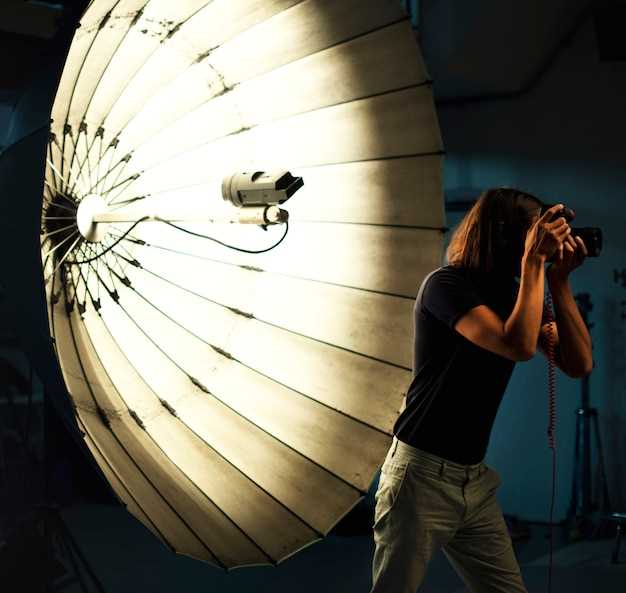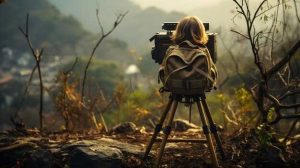

When it comes to capturing the perfect photograph, understanding the nuances of light is paramount. Light has the ability to transform an ordinary scene into a mesmerizing work of art, evoking emotions and telling stories. Whether you are a professional photographer or an amateur enthusiast, harnessing the power of both natural and artificial light can elevate your photography to new heights.
Embracing the Natural Light: Nature provides us with an abundant source of light that can create stunning effects in our photographs. The soft, diffused light of a cloudy day can add a dreamy and ethereal quality to your subjects, while the warm golden hour light during sunrise or sunset can cast a magical glow. Understanding how to work with natural light, whether it’s positioning your subject to catch the best light or using reflectors to bounce light onto your subject, can make all the difference in capturing breathtaking images.
Unleashing the Power of Artificial Light: While natural light is beautiful, artificial light offers photographers a world of creative possibilities. From studio lighting setups to portable flash units, artificial light allows you to have complete control over the lighting conditions of your shoot. Experimenting with different light sources, such as softboxes, umbrellas, or even household lamps, can help you create dramatic effects, highlight specific details, or add depth and dimension to your photographs.
Mastering the art of illumination in photography requires a deep understanding of how light interacts with your subjects and the environment. It involves experimenting with different lighting techniques, understanding the qualities of different light sources, and learning how to manipulate light to achieve your desired results. Whether you prefer the natural beauty of sunlight or the controlled precision of artificial lighting, honing your skills in both areas will allow you to capture stunning photographs that truly showcase the power of light.
Mastering Lighting Techniques for Captivating Photographs
When it comes to photography, understanding how to manipulate light is essential for creating stunning and captivating images. The way light interacts with your subject can dramatically affect the mood, composition, and overall quality of your photographs. In this section, we will explore various lighting tips and techniques that will help you harness the power of light to elevate your photography to the next level.
1. Embrace Natural Light
Natural light, provided by the sun, is a versatile and readily available source that can produce beautiful results in your photographs. Understanding how to work with natural light is crucial for capturing the desired atmosphere and emphasizing the details of your subject. Experiment with different times of the day, such as the golden hour during sunrise or sunset, to achieve soft and warm lighting. Additionally, consider the direction and angle of the light to create interesting shadows and highlights that add depth and dimension to your images.
2. Utilize Artificial Lighting
While natural light is often preferred for its organic and authentic feel, artificial lighting can offer more control and consistency in certain situations. Whether you are shooting indoors or in low-light conditions, incorporating artificial light sources such as studio lights, speedlights, or even household lamps can help you achieve the desired lighting setup. Experiment with different lighting modifiers, such as softboxes or umbrellas, to diffuse or direct the light for a softer or more dramatic effect. Understanding how to balance artificial light with the ambient light is key to creating a natural-looking image.
- Experiment with different lighting angles and positions to create unique shadows and highlights.
- Consider using reflectors or bounce cards to fill in shadows and add a touch of light to your subject.
- Don’t be afraid to play with light intensity and color temperature to evoke specific emotions or moods in your photographs.
- Pay attention to the background and how it interacts with the light to ensure a cohesive and visually pleasing composition.
- Continuously practice and experiment with different lighting setups to develop your own style and master the art of lighting in photography.
By understanding and implementing these lighting tips and techniques, you will be able to create visually striking photographs that effectively convey your artistic vision and leave a lasting impression on your viewers.
The Importance of Lighting in Photography
Lighting plays a crucial role in the world of photography, serving as the foundation upon which captivating images are built. It is the key element that brings life, depth, and emotion to a photograph, enhancing its overall impact and visual appeal. Whether it is natural light streaming through a window or carefully positioned artificial lights, understanding how to manipulate and utilize lighting effectively is essential for photographers to create stunning and memorable images.
Illuminate the Subject: Proper lighting allows photographers to highlight the subject of their photographs, drawing attention to its unique features and capturing its essence. By skillfully manipulating light, photographers can create a sense of drama, emphasizing certain aspects of the subject while minimizing distractions. Whether it is a soft, diffused light for a portrait or a dramatic, directional light for a still life, the right lighting can transform an ordinary subject into a work of art.
Create Mood and Atmosphere: Lighting has the power to evoke emotions and set the mood in a photograph. The intensity, direction, and color temperature of light can all contribute to the overall atmosphere of an image. Soft, warm light can create a cozy and intimate ambiance, while harsh, cool light can convey a sense of tension or unease. By understanding how different lighting techniques can influence the mood, photographers can effectively communicate their intended message and elicit a specific emotional response from viewers.
Enhance Depth and Dimension: Lighting is instrumental in creating depth and dimension in a photograph. By carefully positioning lights and manipulating shadows, photographers can add texture and volume to their images, making them appear more three-dimensional. This technique is particularly important in still life and product photography, where the use of lighting can make objects appear more tactile and realistic. Additionally, lighting can also be used to separate the subject from the background, creating a sense of depth and adding visual interest to the composition.
Control the Narrative: Lighting can be used as a storytelling tool in photography, allowing photographers to control the narrative and guide the viewer’s attention. By selectively illuminating certain elements within a frame, photographers can direct the viewer’s gaze and emphasize specific details or moments. Lighting can also be used to create visual cues and convey symbolism, adding layers of meaning to the photograph. Whether it is a spotlight on a subject’s face or a subtle play of light and shadow, the strategic use of lighting can enhance the narrative and make the photograph more compelling.
In conclusion, understanding the importance of lighting in photography is crucial for photographers who aim to create impactful and visually stunning images. By harnessing the power of light, photographers can illuminate their subjects, create mood and atmosphere, enhance depth and dimension, and control the narrative. Mastering the art of lighting opens up a world of creative possibilities, allowing photographers to capture moments and tell stories in a way that captivates and resonates with viewers.
Natural Light: The Basics
Exploring the fundamental principles of natural light is essential for photographers seeking to capture stunning images. By understanding the characteristics and nuances of natural light, photographers can harness its power to create captivating compositions.
Embracing the Dynamic Nature of Natural Light
Natural light is a dynamic force that changes throughout the day, offering a diverse range of lighting conditions. From the soft, warm glow of sunrise and sunset to the harsh, direct light of midday, each moment presents a unique opportunity to capture different moods and atmospheres in your photographs.
By observing and adapting to the ever-changing natural light, photographers can enhance their images and evoke specific emotions. Understanding how the angle, intensity, and color temperature of natural light impact a scene allows photographers to make informed decisions about composition, exposure, and post-processing techniques.
Utilizing Natural Light for Portraits and Still Life
Natural light can be particularly advantageous when photographing portraits and still life subjects. Its soft, diffused quality can create a flattering and natural-looking illumination, highlighting the subject’s features and textures without the need for additional artificial lighting.
When shooting portraits, positioning the subject near a window or in open shade can provide a beautiful, even light that minimizes harsh shadows and creates a pleasing aesthetic. Similarly, when capturing still life scenes, utilizing natural light can add depth and dimension to the subject, enhancing its visual appeal.
Experimenting with different times of day and locations can further enhance the impact of natural light in your photography. By understanding the basics of natural light and its potential for creating stunning images, photographers can elevate their craft and capture the beauty of the world around them.
Harnessing Natural Light for Stunning Photos
Mastering the art of capturing breathtaking photographs relies heavily on the ability to harness the beauty of natural light. The interplay between light and shadow, the softness or intensity of the sunlight, and the way it illuminates the subject can all contribute to creating stunning images that evoke emotion and captivate the viewer.
When it comes to utilizing natural light in photography, it’s essential to understand how to work with the available light sources and manipulate them to achieve the desired effect. By carefully observing the environment and the way light interacts with different surfaces, photographers can make informed decisions about positioning, timing, and composition to enhance the visual impact of their photos.
One of the key aspects of harnessing natural light is being able to adapt to changing conditions. Whether it’s the soft, warm glow of the golden hour or the harsh, direct light of midday, each lighting situation presents unique opportunities and challenges. Photographers must learn to embrace these variations and use them to their advantage, adjusting their settings and techniques accordingly to achieve the desired outcome.
Another crucial factor in harnessing natural light is understanding how it affects the mood and atmosphere of a photograph. Soft, diffused light can create a dreamy, romantic ambiance, while strong, directional light can add drama and intensity. By recognizing the qualities of different types of natural light and experimenting with various angles and positions, photographers can manipulate the mood of their images to convey their intended message.
Furthermore, the use of natural light allows for a more organic and authentic feel in photographs. It can highlight textures, emphasize details, and bring out the natural colors of the subject, resulting in images that feel alive and vibrant. By avoiding artificial lighting and relying solely on the available natural light, photographers can capture the true essence of their subjects and create images that resonate with viewers on a deeper level.
In conclusion, harnessing natural light is a skill that every photographer should strive to master. By understanding the nuances of different lighting conditions, adapting to changing environments, and utilizing the unique qualities of natural light, photographers can elevate their work and create stunning photos that leave a lasting impression.
Artificial Light: Types and Techniques
Exploring the realm of artificial light in photography opens up a world of possibilities for capturing stunning images. Understanding the various types of artificial light sources and mastering the techniques to harness their potential can greatly enhance the visual impact of your photographs.
Types of Artificial Light Sources
Artificial light sources come in a variety of forms, each with its own unique characteristics and applications. One commonly used type is tungsten lighting, which produces a warm and cozy glow reminiscent of traditional incandescent bulbs. Another popular option is fluorescent lighting, known for its cool and even illumination. LED lights have gained popularity in recent years due to their energy efficiency and versatility. They offer a wide range of color temperatures and can be easily adjusted to create the desired mood and atmosphere. Additionally, strobe lights, also known as flashlights, provide a powerful burst of light for freezing fast-moving subjects or adding dramatic effects to your images.
Techniques for Working with Artificial Light

Mastering the techniques for working with artificial light is essential for achieving professional-looking results. One important aspect is understanding the concept of light direction. By positioning the light source at different angles relative to your subject, you can create various effects, such as soft and diffused lighting or dramatic shadows. Another technique is using light modifiers, such as umbrellas, softboxes, or reflectors, to control the intensity and quality of the light. These tools help to shape and direct the light, allowing you to achieve the desired mood and highlight specific areas of your composition. Additionally, experimenting with different color gels or filters can add a creative touch to your images, allowing you to play with color contrasts and create unique visual effects.
By familiarizing yourself with the types of artificial light sources available and mastering the techniques for working with them, you can expand your creative possibilities in photography and elevate the overall impact of your images.
Combining Natural and Artificial Light for Creative Effects

Exploring the synergy between natural and artificial light sources can unlock a world of creative possibilities in photography. By seamlessly blending these two types of light, photographers can achieve unique and captivating effects that enhance the visual impact of their images.
One approach to combining natural and artificial light is to use artificial light as a supplement to natural light. This technique allows photographers to fill in shadows or add highlights to their subjects, creating a more balanced and dynamic composition. By strategically placing artificial light sources, such as strobes or continuous lights, photographers can control the intensity and direction of light to achieve the desired effect.
Another method is to use artificial light to mimic or enhance the qualities of natural light. By carefully adjusting the color temperature and intensity of artificial light sources, photographers can replicate the warm glow of golden hour or the cool tones of twilight. This technique adds a touch of realism to the image while also allowing for creative interpretation and manipulation of the lighting conditions.
Combining natural and artificial light also opens up opportunities for experimentation and artistic expression. By juxtaposing different light sources, photographers can create dramatic contrasts, play with shadows and highlights, and evoke specific moods or emotions. This interplay between natural and artificial light can add depth, dimension, and visual interest to photographs, elevating them from ordinary to extraordinary.
- Experiment with different light sources and their placement to achieve the desired effect.
- Consider the color temperature and intensity of artificial light to complement or contrast with natural light.
- Use light modifiers, such as diffusers or reflectors, to shape and control the quality of light.
- Take advantage of the unique characteristics of both natural and artificial light to create visually stunning compositions.
- Remember to always adapt and adjust your approach based on the specific shooting conditions and desired outcome.
By harnessing the power of both natural and artificial light, photographers can push the boundaries of their creativity and produce captivating images that leave a lasting impression on viewers.
Tips for Mastering Lighting in Photography
Enhancing your photography skills involves more than just understanding the technical aspects of your camera. Mastering lighting is a crucial element that can make or break your photographs. Whether you’re shooting indoors or outdoors, natural or artificial light, knowing how to manipulate and control light can greatly improve the quality of your images.
1. Experiment with different light sources: Don’t limit yourself to just one type of light source. Explore the possibilities of natural light, such as the soft glow of sunrise or the dramatic shadows of sunset. Additionally, experiment with artificial light sources like studio lights or even household lamps to create unique and captivating effects.
2. Understand the direction of light: The direction of light can drastically change the mood and atmosphere of your photographs. Front lighting, where the light source is behind you, creates a well-lit and evenly exposed image. Side lighting, where the light source is at a 90-degree angle to your subject, adds depth and dimension. Backlighting, where the light source is behind your subject, can create silhouettes or a halo effect.
3. Use reflectors and diffusers: Reflectors and diffusers are essential tools for manipulating light. Reflectors bounce light back onto your subject, filling in shadows and creating a more balanced exposure. Diffusers soften harsh light, reducing glare and creating a more pleasing and natural look. Experiment with different sizes and materials to achieve the desired effect.
4. Pay attention to color temperature: Different light sources have different color temperatures, which can affect the overall tone of your photographs. Natural light varies throughout the day, from warm golden hues during sunrise and sunset to cooler blue tones during midday. Artificial light sources, such as fluorescent or tungsten bulbs, also have their own color temperatures. Understanding and adjusting for these variations can help you achieve the desired mood and color balance in your images.
5. Embrace shadows: Shadows are not always something to be avoided. They can add depth, texture, and drama to your photographs. Experiment with different lighting angles to create interesting shadow patterns and play with the interplay of light and darkness in your compositions.
6. Practice, practice, practice: The key to mastering lighting in photography is practice. Take the time to experiment with different lighting setups, both indoors and outdoors. Study the work of other photographers and analyze how they use light in their images. With time and experience, you’ll develop an intuitive understanding of lighting and be able to create stunning photographs that truly capture the essence of your subjects.
- Experiment with different light sources
- Understand the direction of light
- Use reflectors and diffusers
- Pay attention to color temperature
- Embrace shadows
- Practice, practice, practice






